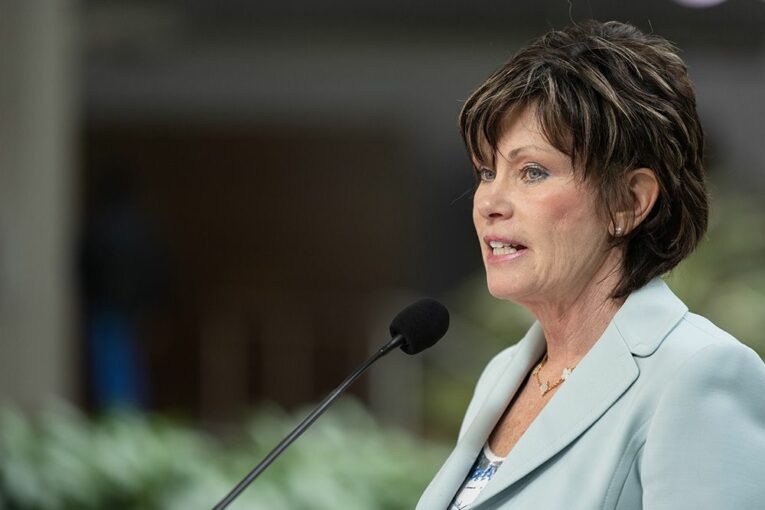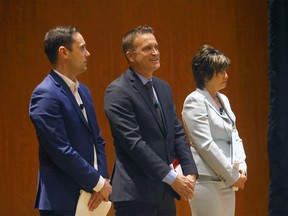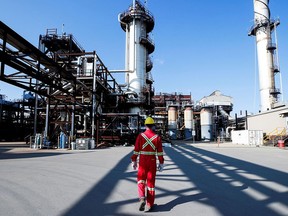
As the province with the largest greenhouse gas emissions in the country, it’s essential Alberta has a solid game plan to reduce those levels in the coming years.
On Wednesday, the UCP government made an aspiration commitment to reach net-zero emissions by 2050 — the first time it’s clearly done so.
It matches the federal government’s target and joins a growing number of countries and companies already moving in that direction.
Yet, it’s still not clear how Alberta will get there; it talks about relying on technological development, as does Ottawa’s own blueprint.
It lacks interim targets for each sector, and it’s not certain what the consequences would be for any player that doesn’t meet provincial goals.
“Before we regulate or impose limits on specific industries and interim targets, there’s more work to be done. We have to see what’s achievable,” Environment Minister Sonya Savage told reporters.
“You can’t build a plan by just picking a random target, attaching it to a random date, and just hope that it will magically work.”
Savage said comprehensive studies still need to be completed on a sector-by-sector basis, which will take a number of months to conduct, at a minimum.
It’s true that Ottawa has in the past selected what seemed to be random emissions targets before it had a clear line of sight to getting there, dating all the way back to the Kyoto accord.
But saying you’re on board with the net-zero goal could be powerful, if it’s followed up with concrete action that provides certainty for consumers, companies, communities and investors.
“That was an incredibly important thing for them to signal,” said Kendall Dilling, president of the Pathways Alliance, a group of large oilsands producers working together to attain a net-zero goal by 2050.
“Clearly, the federal government and hundreds of countries . . . and industries around the world are all taking on that ambitious commitment. For Alberta to be lockstep with that, as a huge natural resource developer, makes sense.”
Recommended from Editorial
-

Alberta aims for net-zero emissions by 2050 in ‘aspirational’ climate plan
-

Varcoe: Natural gas giant seeks to boost demand, lower emissions through fuel station deal
-

Varcoe: Canada pushes ahead on carbon capture projects, but still awaits green lights
What makes the plan important is it “marks a point of broad alignment” between the federal government, major political parties in Alberta and the majority of industry on the target, added Scott Crockatt of the Business Council of Alberta.
Adopting a net-zero goal by 2050 is noteworthy and represents progress for the province, said Simon Dyer of the Pembina Institute. However, he was disappointed by the scant detail, such as a lack of a 2030 emissions target for Alberta or what steps each sector must take.
“It’s not really a plan. It doesn’t actually provide the level of detail or rigour that you’d expect from a major modern energy jurisdiction in 2023.”
The 65-page blueprint talks about promoting energy security and reliability as the world moves to decarbonize. The plan also seeks to capitalize on the enormous opportunities for investment, projects and jobs in Alberta through the energy transition.
While lacking sector-specific emissions-reduction targets, the report does indicate a few new steps are on the way.
The government will consult with various groups to lower provincial methane emissions from the conventional oil and gas industry by 75 to 80 per cent by the end of this decade (down from 2014 levels) — meeting or exceeding Ottawa’s aspirations.
It will explore creating new low-carbon minimum blending rates for utilities for natural gas, such as adding hydrogen or biogas to lower emissions.
The government will examine lowering Alberta’s legislated 100-megatonne oilsands emissions limit, which was introduced by the former NDP government.

The plan’s release also comes against the backdrop of a provincial election campaign and new federal data on greenhouse gas emissions that underscore the hurdles ahead to meet the target.
Last week, the annual release of federal emissions data noted Alberta’s levels have increased by nearly nine per cent since 2005, primarily as oilsands production ramped up.
In 2021, the latest year of available data, Alberta’s emissions represented about 38 per cent of the country’s overall total. And the oil and gas sector remains the country’s largest emitting sector.
The provincial document details what work has already been done across a number of areas, highlighting the growth of renewables, the early phaseout of coal-fired power generation and ongoing progress to lower emissions per barrel from the oilpatch.
The emissions intensity of bitumen has dropped by 21 per cent in the past decade. Adopting technology such as carbon capture, utilization and storage (CCUS) at scale will be essential to hitting the 2050 target.
The province issued 25 permits for potential CCUS hubs last year. The Pathways Alliance is planning to build a $16.5-billion CCUS hub in the Cold Lake area, while other industries — such as the cement and the power generation sector — are also planning for large projects.
By the end of this decade, the power industry is expected to lower its emissions in the province by 61 per cent from 2005 levels.

Yet, the lack of any interim targets or other specifics will make this strategy an easy target.
“By their own admission, this so-called plan is purely aspirational, does not set firm targets, lacks accountability and relies on technology that is yet to be deployed,” NDP MLA Marlin Schmidt said in a statement.
University of Alberta energy economist Andrew Leach, who chaired the province’s 2015 climate leadership committee, doesn’t understand why the province lacks the information or data to put out a more detailed plan.
“It’s not changing anything looking forward in a big way,” Leach said. “I didn’t see anything that was really new there.”
The province has embraced the net-zero target, finally.
However, the toughest details — how to get there in a world that needs more energy, and in a province that needs to attract billions of dollars in investment to decarbonize — must still be resolved.
Chris Varcoe is a Calgary Herald columnist.
You can read more of the news on source
